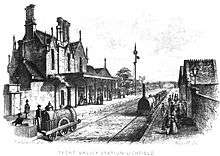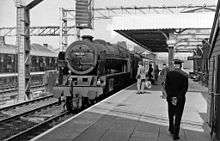Lichfield Trent Valley railway station
| Lichfield Trent Valley | |
|---|---|
|
Northward view of the low-level platforms. | |
| Location | |
| Place | Lichfield |
| Local authority | District of Lichfield |
| Coordinates | 52°41′12″N 1°48′01″W / 52.68662°N 1.80024°WCoordinates: 52°41′12″N 1°48′01″W / 52.68662°N 1.80024°W |
| Grid reference | SK136099 |
| Operations | |
| Station code | LTV |
| Managed by | London Midland |
| Number of platforms | 3 |
| DfT category | E |
|
Live arrivals/departures, station information and onward connections from National Rail Enquiries | |
| Annual rail passenger usage* | |
| 2010/11 |
|
| 2011/12 |
|
| 2012/13 |
|
| 2013/14 |
|
| 2014/15 |
|
| History | |
| Key dates | Opened 1847 |
| Original company |
Trent Valley Railway South Staffordshire Railway |
| Pre-grouping | London and North Western Railway |
| Post-grouping | London, Midland and Scottish Railway |
| 15 September 1847 | Original station on Trent Valley Rly opened as Lichfield |
| August 1849 | Station on South Staffs Rly opened as Lichfield Trent Valley Junction |
| 3 July 1871 | Earlier stations closed; present Lichfield Trent Valley station opened |
| 18 January 1965 | High Level platforms closed |
| 28 November 1988 | High Level platform re-opened |
| National Rail – UK railway stations | |
| * Annual estimated passenger usage based on sales of tickets in stated financial year(s) which end or originate at Lichfield Trent Valley from Office of Rail and Road statistics. Methodology may vary year on year. | |
|
| |
Lichfield Trent Valley is a split-level railway station on the outskirts of the city of Lichfield in Staffordshire, England. It is one of two stations in Lichfield, the other being Lichfield City in the city-centre. The low level platforms are served by the Trent Valley section of the West Coast Main Line, while the single high level platform serves as the northern terminus of the Cross-City Line.
Location
The station is located 1 mile north-east from the City Centre and serves the East and North side of the city, as well as being used by commuters from surrounding villages, such as Fradley, Alrewas and Whittington. The station bears the name Trent Valley, as do other stations on the line such as Rugeley Trent Valley, due to the fact that the line was opened by the Trent Valley Railway, which ran between Rugby and Stafford.[1] The River Trent is found around 6 miles north of Lichfield Trent Valley at Wynchnor Junction, where it is joined by two of its tributaries, the River Tame and the River Mease. Access to the station is from the A5127. The station serves as a connecting station for travellers wishing to get to Birmingham on the Cross-City Line.
Features

Its low-level platforms are located on the Trent Valley Line section of the West Coast Main Line (WCML). Facilities are basic – the original station buildings on the low-level platforms were demolished in 1969 and replaced with a basic wooden building and shelter.[2][3]
Above this, a single platform at a right-angle to the low-level platforms, forms the high-level part of the station. This is the northern terminus of the Cross-City Line, which passes over the WCML on a bridge. The high-level platform is connected by stairs from the low-level platforms and also serves as a footbridge for passenger access to the southbound low-level platform.
North of the high-level station, the line continues to Wychnor Junction where it joins the Cross Country Route towards Derby. This stretch of line remains open for freight trains and occasional diversions, but no longer has a passenger service. Passenger services used to run north to Alrewas and Burton-on-Trent, but these ceased when the high-level station was closed in 1965. One platform of the high-level station was reopened as the northern terminus of the Cross City Line in 1988 by British Rail, with southbound services to Birmingham, Longbridge and Redditch only. A single track chord connects the low and high level lines at the north of the station, but this is rarely used.[2][3]
Services
West Coast Main Line
In the current (May 2013) timetable there is a basic daytime frequency of one train per hour each way (including Sundays) – southbound to London Euston via Milton Keynes Central and northbound to Crewe via Stafford and Stoke-on-Trent.[4] Additional Virgin Trains services also call, providing links to Manchester Piccadilly, Lancaster, Glasgow Central, Liverpool Lime Street, Crewe, Preston and Carlisle in the northbound direction and to London southbound.[5] Virgin Trains services operate in the weekday peaks. Grand Central has been given permission to run six trains a day from London to Blackpool North from 2018, with conditional permission for a stop at Lichfield dependent upon future capacity after infrastructural work.[6]
Cross City Line
There are two trains per hour throughout the day on the Cross-City line to Redditch or Longbridge. On Sundays there is typically a half-hourly service to Redditch serving all stations en route.[7]
History



The Trent Valley Railway (TVR), which connected the London and Birmingham Railway (L&BR) at Rugby with the Grand Junction Railway (GJR) at Stafford, was formed on 21 July 1845[8] and opened on 15 September 1847,[9] and included a station at Lichfield;[10] in the meantime, the L&BR, GJR and Manchester and Birmingham Railway had amalgamated in July 1846 as the London and North Western Railway (LNWR),[11] which itself absorbed the TVR later in 1846.[9] This first station at Lichfield was built in 1847. This station was situated north of Burton Road approximately 0.2 miles north of the current crossing point. The architect, John William Livock, built the station in a Tudor Gothic style.[12]
The South Staffordshire Railway (SSR), which connected Dudley with Burton-on-Trent, was formed on 6 October 1846 by amalgamation of two smaller railways, both of which had been formed on 3 August 1846.[13] The line north of Walsall opened on 9 April 1849,[14] but the station named Lichfield Trent Valley Junction was not opened until August 1849.[10] Lichfield Trent Valley Junction was built south of Burton Road close to Streethay just past the present signal box. From it a spur line descended to the other station north of the crossing point to allow passengers to transfer to the LNWR main line below.[15] The SSR was leased to the LNWR in February 1861, and was absorbed by that company on 15 July 1867.[16]
On 3 July 1871, both of these stations were closed by the LNWR, which replaced them with a single station; Lichfield Trent Valley was built in its present location with high and low-level platforms adjoining each other. The Low Level platforms, serving the Rugby-Stafford line, were situated approximately 400 m (440 yd) south of the original TVR station. The High Level platforms closed on 18 January 1965 with the withdrawal of passenger services between Lichfield City and Burton-on-Trent. On 28 November 1988, the service between Birmingham and Lichfield City was extended, and initially both of the High Level platforms at Lichfield Trent Valley were reopened as a terminus, with steps leading up to both sides from the low level platforms.[10][17] At that time the service was hourly, and the diesel units were shunted as empty coaching stock North from the Down Walsall platform to just past the high level signalbox. There they would be crossed over to the Up Walsall line and proceed into the up platform.[18] These workings remained in place until the now current trailing crossover just south of the high level platform was opened during the electrification and upgrading of the line in 1992. Once the new trailing crossing had been commissioned the Up Walsall platform was closed and the electric trains terminated in the Down Walsall platform without requiring a shunt move to reverse.
The signal box was demolished over the weekend of 15 June 2008 as part of the West Coast upgrade.
In December 2013 work started on an upgrade to the station, this included the opening of an additional car park in February 2014 and construction of a new station building.[19]
1946 accident
On New Year's Day 1946 it was the site of a points failure resulting in an express Fleetwood to London Broad Street fish train being diverted into a stationary local passenger train standing in the up platform loop, resulting in the deaths of 20 people and injury of 21 more. The disaster is one of the very rare cases in the UK of mechanical point interlocking failing to prevent an accident.
Notes
- ↑ Awdry, Christopher (1990). Encyclopaedia of British Railway Companies. London: Guild Publishing. p. 107. CN 8983.
- 1 2 "Lichfield Domestic Buildings". british-history.ac.uk. Retrieved 22 October 2013.
- 1 2 Doherty, Andrew. "Lichfield Trent Valley 1847 to present". Rails around Birmingham & the West Midlands.
- ↑ GB eNRT December 2015 Edition, Table 67
- ↑ GB eNRT December 2015 Edition, Table 65 (Network Rail)
- ↑ Topham, Gwyn. "Virgin has a rival: GNWR to run London to Blackpool west coast rail service". The Guardian. Retrieved 7 August 2015.
- ↑ GB eNRT December 2015 Edition, Timetable 69: Lichfield – Birmingham – Longbridge and Redditch (Network Rail)
- ↑ Awdry 1990, p. 107.
- 1 2 James 1983, p. 48.
- 1 2 3 Butt 1995, p. 142.
- ↑ James 1983, p. 43.
- ↑ Clayton 1981, p. 27.
- ↑ Awdry 1990, pp. 103,107.
- ↑ James 1983, p. 59.
- ↑ Clayton 1981, p. 46.
- ↑ James 1983, p. 50.
- ↑ Baker 2007, p. 41, section A2.
- ↑ ex-signalman recalls
- ↑ "Work underway on £900,000 improvements at Lichfield Trent Valley railway station – but still no lift for disabled passengers". Lichfield Mercury. 17 December 2013. Retrieved 19 March 2014.
References
- Awdry, Christopher (1990). Encyclopaedia of British Railway Companies. London: Guild Publishing. CN 8983.
- Baker, S.K. (April 2007) [1977]. Rail Atlas Great Britain & Ireland (11th ed.). Hersham: Oxford Publishing Co. ISBN 978-0-86093-602-2. 0704/K.
- Butt, R.V.J. (1995). The Directory of Railway Stations. Yeovil: Patrick Stephens Ltd. ISBN 1-85260-508-1. R508.
- Clayton, Howard (1981). Cathedral City: A Look at Victorian Lichfield. Abottsford Publishing. ISBN 978-0-9503563-1-0.
- James, Leslie (November 1983). A Chronology of the Construction of Britain's Railways 1778–1855. Shepperton: Ian Allan. ISBN 0-7110-1277-6. BE/1183.
- Whittaker, Nicholas (1995). Platform Souls. London: Gollancz. ISBN 0-575-05981-8.
External links
| Wikimedia Commons has media related to Lichfield Trent Valley railway station. |
- Train times and station information for Lichfield Trent Valley railway station from National Rail
- Rail Around Birmingham and the West Midlands: Lichfield Trent Valley station
| Preceding station | |
Following station | ||
|---|---|---|---|---|
| London Midland London – Crewe | ||||
| Terminus | London Midland | |||
| Virgin Trains London-Manchester | ||||
| Virgin Trains | ||||
| Historical railways | ||||
Line and station closed | London and North Western Railway | Line and station open |
||
